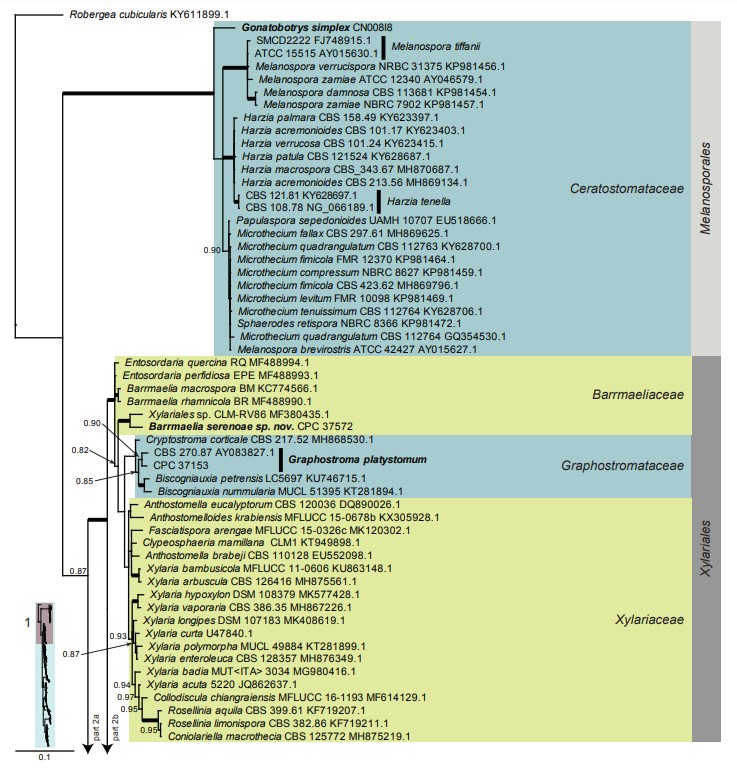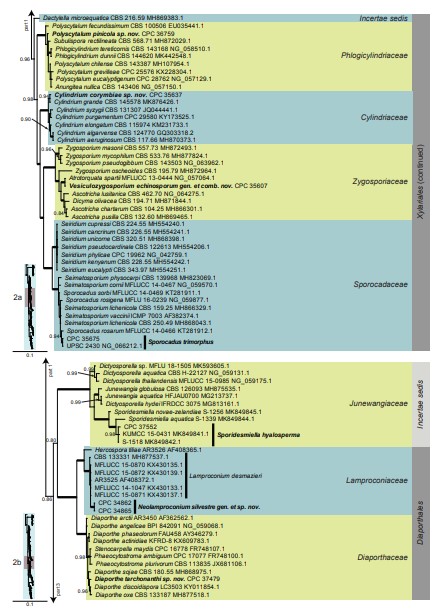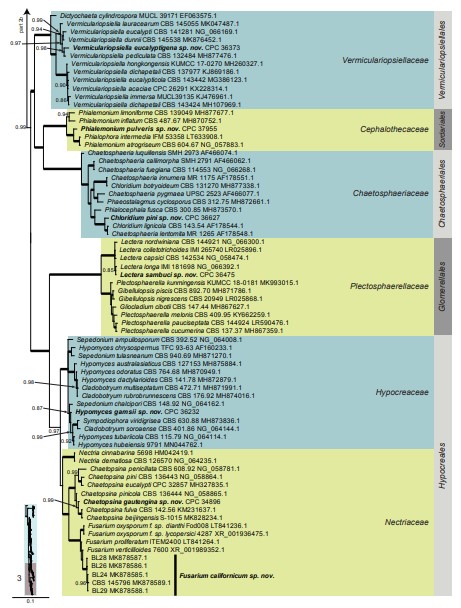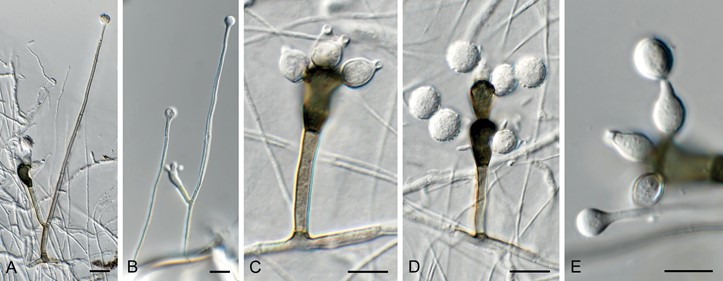Vesiculozygosporium echinosporum (Bunting & E.W. Mason) Crous, in Crous, Wingfield, Schumacher, Akulov, Bulgakov, Carnegie, Jurjević, Decock, Denman, Lombard, Lawrence, Stack, Gordon, Bostock, Burgess, Summerell, Taylor, Edwards, Hou, Cai, Rossman, Wöhner, Allen, Castlebury, Visagie & Groenewald, Fungal Systematics and Evolution 6: 227 (2020) comb. nov.
MycoBank number: MB 835111; Index Fungorum number: IF 835111; Facesoffungi number: FoF 14959.
Basionym – Zygosporium echinosporum Bunting & E.W. Mason, In Mason, Annot. Acct Fungi rec’d Imp. Mycol. Inst. 2: 135. 1941.
Mycelium consisting of hyaline, smooth, branched, septate, 2–2.5 µm diam hyphae. Conidiophores arising directly from superficial mycelium, or from a cylindrical stipe, erect, medium brown, smooth, subcylindrical, unbranched, 2–3-septate, 20–60 × 3.5–4 µm, giving rise to conidiophore as lateral branch, forming a stipe extension, 100–160 × 2–3 µm, 3–4-septate, terminating in a sphaeropedunculate vesicle, pale brown, finely roughened, (6–)6.5(–7) µm. Vesicular cell dark brown, smooth, clavate, curved (hooked), 13–15 × 8–10 µm, giving rise to 3–4 conidiogenous cells. Conidiogenous cells terminal and lateral on apex of hooked vesicular cell, doliiform, pale brown, smooth, phialidic, 7–9 × 5–6 µm, apex with cylindrical collarette, 1–2 × 1.5–2 µm. Conidia solitary, globose, verruculose, thick-walled, pale brown, guttulate, scar visible, (8–)9(–10) µm diam.
Culture characteristics – Colonies flat, spreading, with moderate aerial mycelium and smooth, lobate margin, reaching 10 mm diam after 2 wk at 25 ºC. On MEA, PDA and OA surface and reverse olivaceous grey.
Material examined – Malaysia, on leaves of Muntingia calabura (Muntingiaceae), 29 Mar. 2018, M.J. Wingfield, HPC 2395 = CBS H-24047, culture CPC 35607 = CBS 145807.
Notes – Zygosporium has three generic synonyms, namely Pimina, Urobasidium and Urophiala, but as the type species of these genera lack setiform conidiophores, they do not apply to Zygosporium echinosporum. Zygosporium echinosporum is phylogenetically identical to an LSU sequence deposited for Atrotorquata spartii. However, the ITS (from MFLU 14-0821/ MFLUCC 13-0445; Jian-Kui Liu, pers. comm.) and LSU (from holotype MFLU 14-0738 / ex-type culture MFLUCC 13-0444; GenBank KP325443.1) sequences for this taxon are incongruent, and as the type species of Atrotorquata is A. lineata (not known from DNA sequence), we rather choose to introduce a new genus, Vesiculozygosporium, to accommodate Z. echinosporum. It could well be that other species of Zygosporium with vesiculate setae and setiform conidiophores also belong to Vesiculozygosporium, but cultures and additional phylogenetic studies would be required to confirm this hypothesis. Based on a megablast search of NCBI’s GenBank nucleotide database, the closest hits using the ITS sequence had highest similarity to Zygosporium echinosporum (strain CBS 247.72, GenBank MH860466.1; Identities = 518/519 (99 %), 1 gap (0 %)), Ascotricha chartarum (strain BPS247, GenBank MH700426.1; Identities = 403/452 (89 %), 13 gaps (2 %)), and Ascotricha erinacea (strain CBS 535.73, GenBank KF893285.1; Identities = 469/528 (89 %), 17 gaps (3 %)). Closest hits using the LSU sequence are Atrotorquata spartii (strain MFLUCC 13-0444, GenBank NG_057064.1; Identities = 851/851 (100 %), no gaps), Ascotricha chartarum (strain HMCK-30, GenBank MK051166.1; Identities = 835/852 (98 %), 1 gap (0 %)), and Dicyma olivacea (strain CBS 116.31, GenBank MH866600.1; Identities = 832/851 (98 %), no gaps) – also see Fig. 6, part 2a.

Fig. 6, parts 1–3. Consensus phylogram (50 % majority rule) resulting from a Bayesian analysis of the Sordariomycetes LSU sequence alignment. Bayesian posterior probabilities (PP) > 0.79 are shown at the nodes and the scale bar represents the expected changes per site. Thickened branches represent PP = 1. Families and orders are indicated with coloured blocks to the right of the tree. GenBank accession and/or culture collection numbers are indicated for all species. The tree was rooted to Robergea cubicularis (voucher G.M. 2013-05-09.1, GenBank KY611899.1) and the species treated in this study for which LSU sequence data were available are indicated in bold face. A miniature overview tree is also presented to facilitate navigation along the tree topology.

Fig. 6. (Continued).

Fig. 6. (Continued).

Fig. 62. Vesiculozygosporium echinosporum (CPC 35607). A, B. Conidiophores. C–E. Conidiogenous cells and conidia. Scale bars = 10 µm.
